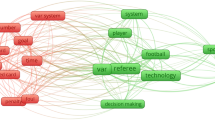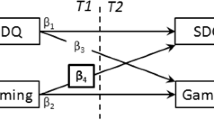Abstract
Players invest significant physical effort when playing exertion games. In addition to improving physical health, exertion games are also believed to facilitate social play amongst players. Despite these advantages, our understanding of how to design these games to successfully support social play is limited. In this paper, we present a qualitative analysis of player data from “Table Tennis for Three”, a mediated exertion game for three players, that contributes to our understanding of how the design of an exertion game facilitates social play. We use the concept of “space” to frame our findings in order to create themes that can be used to analyze existing and to design future exertion games. We hope our work can support researchers gain an understanding of this exciting new field, while also help designers utilize the many benefits of exertion games.




Similar content being viewed by others
References
Behrenshausen BG (2007) Toward a (Kin) aesthetic of video gaming: the case of Dance Dance Revolution. Games Cult 2(4):335
Bianchi-Berthouze N, Kim W, Patel D (2007) Does body movement engage you more in digital game play? and why? Paper presented at the affective computing and intelligent interaction conference. http://dx.doi.org/10.1007/978-3-540-74889-2_10
Bortz J, Doring N (2002) Forschungsmethoden und evaluation. Springer, Berlin
Consolvo S, Everitt K, Smith I, Landay JA (2006) Design requirements for technologies that encourage physical activity. Paper presented at the SIGCHI conference on human factors in computing systems
de Kort YAW, Ijsselsteijn WA (2008) People, places, and play: player experience in a socio-spatial context. Comput Entertain (CIE) 6(2)
Dourish P (2001) Where the action is: the foundations of embodied interaction. MIT Press, USA
Eriksson E, Hansen T, Lykke-Olesen A (2007) Movement-based interaction in camera spaces: a conceptual framework. Pers Ubiquit Comput 11(8):621–632
Fitzpatrick G (2002). The locales framework: making social thinking accessible for software practitioners. In: Social thinking: software practice. MIT Press, USA, pp 141–160
Fogtmann MH, Fritsch J, Kortbek KJ (2008) Kinesthetic interaction—revealing the bodily potential in interaction design. Paper presented at the OZCHI ‘08: conference of the Computer–Human Interaction Special Interest Group (CHISIG) of Australia on Computer–Human Interaction
Graves L, Stratton G, Ridgers ND, Cable NT (2007) Comparison of energy expenditure in adolescents when playing new generation and sedentary computer games: cross sectional study. BMJ 335(7633):1282–1284
Hoonhout J, Fontijn W (2008) It’s hard, it is fun: throwing balls inside the home. Paper presented at the SIGCHI conference on Human factors in computing systems. Workshop Exertion Interfaces. http://workshopchi.pbwiki.com/f/CHI2008_splashball_exertion_interfaces_uploaded.pdf
Larssen AT, Loke L, Robertson T, Edwards J, Sydney A (2004) Understanding movement as input for interaction—a study of two Eyetoy™ Games. In: Proceedings of OzCHI ‘04
Lindley SE, Le Couteur J, Berthouze NL (2008) Stirring up experience through movement in game play: effects on engagement and social behaviour. Paper presented at the Proceeding of the twenty-sixth annual SIGCHI conference on human factors in computing systems
Moen J (2006) Kinaesthetic movement interaction: designing for the pleasure of motion. Unpublished PhD, KTH, Numerical Analysis and Computer Science, Stockholm
Mueller F (2002) Exertion interfaces: sports over a distance for social bonding and fun. Unpublished Master of Science, Massachusetts Institute of Technology
Mueller F, Agamanolis S, Picard R (2003) Exertion interfaces: sports over a distance for social bonding and fun. Paper presented at the SIGCHI conference on human factors in computing systems
Mueller F, Gibbs M (2007a) A physical three-way interactive game based on table tennis. Paper presented at the 4th Australasian Conference on Interactive Entertainment
Mueller F, Gibbs M (2007b) Evaluating a distributed physical leisure game for three players. Paper presented at the conference of the computer-human interaction special interest group (CHISIG) of Australia on computer–human interaction: OzCHI’07
Mueller F, Gibbs M, Vetere F (2008). Taxonomy of exertion games. Paper presented at the OZCHI ‘08: conference of the computer–human interaction special interest group (CHISIG) of Australia on computer–human interaction
Mueller F, Gibbs M, Vetere F (2009) Design influence on social play in distributed exertion games. Paper presented at the CHI ’09. In: Proceedings of the SIGCHI conference on human factors in computing systems
Neuman WL (2006) Social research methods, 6th edn. Pearson Education, USA
Nitsche M (2009) Video game spaces: image, play, and structure in 3D worlds. The MIT Press, USA
O’Brien S, Mueller F (2007) Jogging the distance. Paper presented at the proceedings of the SIGCHI conference on human factors in computing systems
Rettie R (2003) Connectedness, awareness and social presence. Paper presented at the Presence 2003, 6th annual international workshop on presence
Salen K, Zimmerman E (2003) Rules of play: game design fundamentals. The MIT Press, USA
Sharp H, Rogers Y, Preece J (2007) Interaction design: beyond human computer interaction. Wiley, New York
Sheridan JG, Bryan-Kinns N (2008) Designing for performative tangible interaction. Int J Arts Technol Spec Issue Tangible Embed Interact 1(3–4)
Strauss A, Corbin J (1998) Basics of qualitative research: techniques and procedures for developing grounded theory. SAGE Publications, London
Strömberg H, Väätänen A, Räty V-P (2002) A group game played in interactive virtual space: design and evaluation. Paper presented at the 4th conference on designing interactive systems
Vossen DP (2004) The nature and classification of games. AVANTE 10(1):53–68
Wakkary R, Hatala M, Jiang Y, Droumeva M, Hosseini M (2008). Making sense of group interaction in an ambient intelligent environment for physical play. Paper presented at the proceedings of the 2nd international conference on tangible and embedded interaction
Webb A, Kerne A, Koh E, Joshi P, Park Y, Graeber R (2006) Choreographic buttons: promoting social interaction through human movement and clear affordances. Paper presented at the proceedings of the 14th annual ACM international conference on multimedia
Weinberg RS, Gould D (2006) Foundations of sport and exercise psychology. Human Kinetics, Champaign
Acknowledgments
The development work for Table Tennis for Three was initially supported by The University of Melbourne and CSIRO Collaborative Research Support Scheme. Thanks to Kerin Bryant for taking the pictures and Beryl Plimmer, Chris Wolf, Christine Satchell and Yolanda Rankin for their editing help. The corresponding author would also like to thank the support from a Microsoft Research Asia Fellowship.
Author information
Authors and Affiliations
Corresponding author
Rights and permissions
About this article
Cite this article
Mueller, F., Gibbs, M.R. & Vetere, F. Towards understanding how to design for social play in exertion games. Pers Ubiquit Comput 14, 417–424 (2010). https://doi.org/10.1007/s00779-009-0268-x
Received:
Accepted:
Published:
Issue Date:
DOI: https://doi.org/10.1007/s00779-009-0268-x




